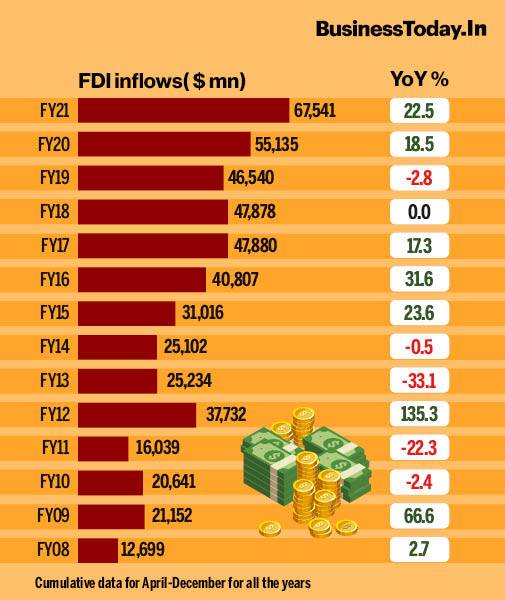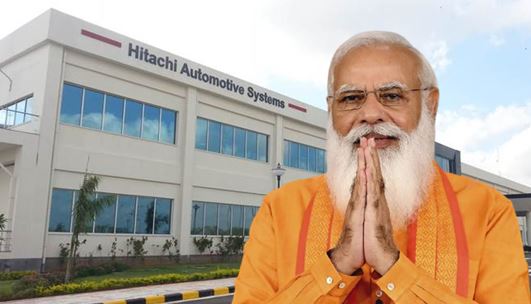On September 25, India marked the seventh year of the ‘Make in India’ initiative. By far Prime Minister Narendra Modi’s most important project, and a flagship one at that, ‘Make in India’ is transforming India and making it a business hub for global manufacturers across a variety of sectors. Manufacturers from sectors like automobiles, electronic consumer goods, pharmaceuticals, defense systems, aviation among others are just a few who have turned to India as their destination to disrupt the existing global supply chains.
What Has India Gained with the ‘Make in India’ Initiative?
After the launch of the initiative, India gave investment commitments worth ₹16.40 lakh crore (US$230 billion) and investment inquiries worth ₹1.5 lakh crore (US$21 billion) between September 2014 to February 2016 alone. As a result, India emerged as the top destination globally in 2015 for foreign direct investment (FDI), surpassing the United States and China, with US$60.1 billion in FDI. India has attracted, FDI inflow of 27.37 billion dollars during the first four months of this financial year, which is 62 per cent higher as compared to the corresponding period last financial year. FDI equity inflow also grew by 112 per cent in the first four months of this financial year compared to the same period last year.

In 2019, the World Bank ranked India 63rd among 190 countries in the ‘Ease of Doing Business’ index. This was a jump of 23 places from its rank of 100 in 2017.
Here’s a look at the manufacturers who are betting on India’s bullish growth and business environment:
- In 2016, Hitachi had set-up an auto-component plant in Chennai which increased their employees count from 10,000 to 13,000. Last month, Hitachi Air Conditioning India, manufacturer of the largest selling air-conditioner brand ‘Hitachi Cooling and Heating’ announced its aggressive expansion plans to capture the promising residential and commercial air conditioning market in Gujarat.
- A new study has shown that as much as 76% of the iPhones that have been sold in India have been made in India itself. The manufacturing partners of Apple – Foxconn, and Winston have ramped up their production in India to avail benefits under the PLI scheme.
- In April 2017, Kia invested over $1.1 billion to build a car manufacturing plant in Anantapur, Andhra Pradesh. The facility is the company’s first manufacturing plant in India.
- In mid-2017, European automobile major PSA partnered with CK Birla Group, to build a car manufacturing plant in Tamil Nadu at the cost of ₹7,000 crore s($1.03 billion). Similarly, in July 2017, SAIC Motor invested ₹2,000 crores ($300 million) to build a car manufacturing plant in Halol, Gujarat.
- French drone manufacturer LH Aviation has announced a manufacturing plant in India to produce drones.
- Boeing announced setting up a factory to assemble fighter planes, either the Apache or Chinook defence helicopter in India, as well as the manufacture of the F/A-18 Super Hornet.
- Meanwhile, Samsung has completed the construction of the display manufacturing unit that has been shifted from China to Noida in Uttar Pradesh. Now the displays of Samsung, that are used in the company’s products as well as by other consumer electronics players, will be manufactured in Noida.
- In 2019, Samsung, the largest smartphone manufacturer in the world, ended its phone production facility in China. The company then turned to India to expand its manufacturing base to compensate for the Chinese manufacturing unit’s shutdown.
- In April 2018, Saudi Arabia’s oil giant, Aramco signed an initial deal with a consortium of Indian refiners to build a $44 billion refinery and petrochemical project on India’s west coast. The project entails a refinery with an output capacity pf 1.2 million barrels per day (BPD), integrated with petrochemical facilities having a total capacity of 18 million tonnes per year.
- India’s arms imports fell by 33% over the last five years and the Make in India initiative has had a major role to play in this.
These are just a few examples of what Make in India has been able to achieve in the past seven years.
Modi Government’s PLI Push for Manufacturers
The production-linked incentive (PLI) scheme was launched in March 2020 to boost domestic manufacturing and cut down on import bills. The scheme will incentivise 13 sectors with a total outlay of 1.97 lakh crores. Recently, the Indian government approved the PLI scheme for the drone and automobile sectors. The incentive provided by the government to the drone sector is 120 crores, while to the auto sector, it is nearly 26,000 crores.
Read more: How many Jobs has the PLI scheme generated, and how many will it generate in the future
As explained by TFI previously, the PLI schemes are about to make India a giant job market. The 6,238-crore incentive to the white goods sector will create four lakh direct and indirect jobs. In the manufacturing sector, incentives provided under the PLI scheme are expected to double the workforce in upcoming years. The 10,683 crore incentives provided to the textile sector are expected to usher more than 7.50 lakhs additional job creation in the sector. The 15,000-crore incentive given to pharmaceuticals will generate 20,000 direct and more than 80,000 indirect jobs.
The Way Forward
Even during his recent visit to the United States, Prime Minister Narendra Modi made it a point to interact with the CEOs of various major global companies, and impressed upon them the benefits of setting up bases in India. The Modi government is focused on bringing in as many global manufacturers to India as possible. By highlighting the vast opportunities in India, PM Modi encouraged the CEOs of Qualcomm Ventures, Adobe, First Solar, General Atomics, and Blackstone to step up their investments in the country. India is set to gain big on the semiconductors, 5G, and solar energy fronts with these meetings.
The Make in India initiative is here to stay. In the coming times, more and more manufacturers are expected to queue up to set up facilities in India. The business environment is increasingly being unshackled in India, and PM Modi is personally leading a wave of reforms that will modernise and open up India’s economy. Rest assured; India has no time to rest. It must constantly look to become the most-favoured destination for businesses from around the world. We have come a long way, but the journey is far from over.































